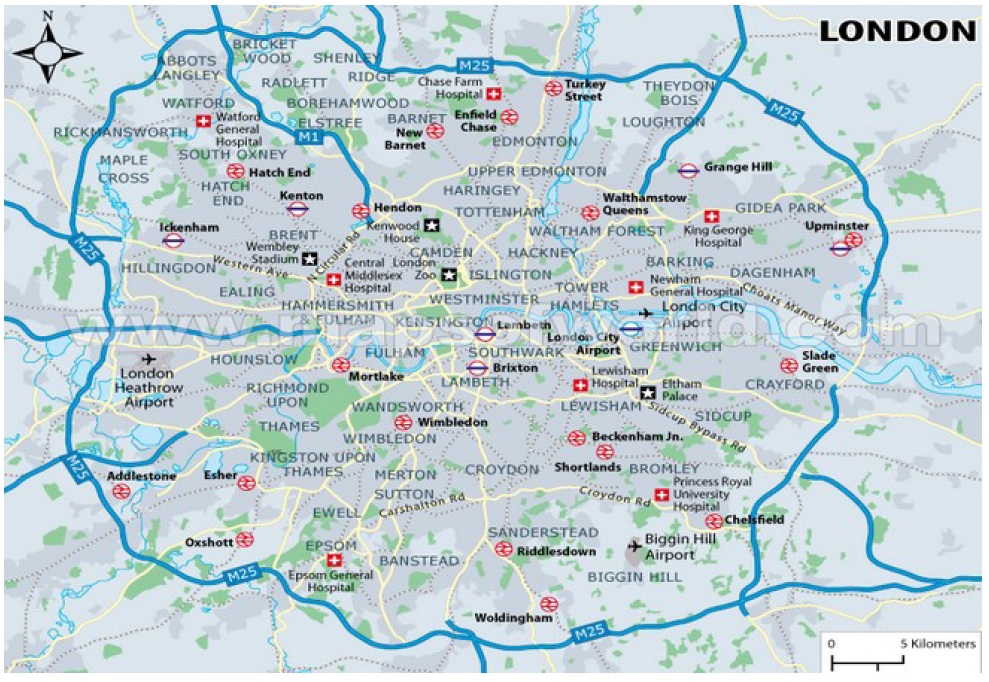London is considered as the main competitor of Paris. Indeed, as the French model, the United
Kingdom has a centralized system, where all the important functions of the country are located in
London (by comparison Germany has many middle cites, Italy has its economic functions based in
Milan and the politic power in Rome).
Figure 3: Administrative map of the Greater London

This explains the good positioning of Paris and London, considered as the two major cities of Europe.
Nevertheless we can analyze London as more advanced in term of organization, as the government has
started to create a competitive city a long time ago.
Indeed from 1984 to 2000, the public transports of London were directly managed by the central
government. In 2000 only, Londoners have been able to vote for the Greater London Authority in
order to give to this institution the power to manage the public transports of London (through its
authority Transport For London)(33). This changing was one of the major projects of Tony Blair.
The Greater London Authority has obtained its legal status through the GLA act voted in 1999. It
gives the function to this institution to develop the urban area of London in term of transports,
environment and urbanization.
The organization system is clear: GLA has to deal with the different Boroughs composing London and
also with the government in order to implement actions (obviously these actions have to respect the
global strategy of London)(34).
The public transports lines of London are exploited by private companies since 1984 (result of the
Thatcher government). Indeed the Greater London Authority and Transports For London are in charge
of controlling the respect of laws by the private companies such as materials, itinerary, price (which is
not the case in the rest of the country)(35). Transports For London also directly manages the highways
of the Greater London, the institution is allowed to perceive some money from the users (vehicles
which want to access to the city centre are charged).
Since 2003, TFL is also in charge of London Underground (before the British government was in
charge of it), and supervises the operation of the stations by private companies (cleaning and technical
issues). TFL decides the price of the journeys. But since 1998, a plan public private partnership has
been set up to privatize the infrastructures (TFL would be sill the operator, but the lines would be
privatize)(36).
This system of public private partnership has generated some damages about the good functioning of
the public transports. First it has been difficult to establish fares, as differences between the bus fares
and the underground fares are observed. Bus fares can be compared to others big cities such as Paris or
New York, but the underground fares are about 50% more expansive than in these two other cities.
Nevertheless, according to these observations, we can already see that London has a much better
organization than Paris. Indeed, the city had the opportunity for already more than ten years to develop
a strategy in order to develop the city efficiently. The government and the Great London authority
think and communicate the global approach which is applied by the boroughs.
Contrary to Paris mayor, the London mayor (Boris Johnson), govern the entire area of London (inner
London and the suburbs) which gives him the power to take decisions for 7.4 million people(37) (by
comparison the urban area of Paris is governed by 1281 mayors(38). All the boroughs depend of the
central city hall, except for the business district of London (City of London), which has its own
administration. This gives a better position to the city to apply a global strategy, with less restriction.
As we have seen London has started to simplify its administration decisions, and clarify its economic
strategic growth. It seems to be a city which understood earlier the globalization opportunities. Tony
Travers (director of the Greater London group at the London School of Economics), in an interview
given to “the economist”, declared that “London has flourished not because it has sorted out its
transport, or its city management, but because it opened its borders”. Indeed, London is commonly
called the “global city”, which can seem really attractive to companies and employees from
everywhere in the world to implement themselves in the United Kingdom’s capital.
Indeed, by opening its borders, London has attracted many high qualified people, which gives a strong
advantage to the city (nearly 700.000 extra foreign-born live in London since 1997(39)).
We are now going to analyze the growth of another big European city: Berlin.
32 Administrative map of London, www.mapsofworld.com, http://fr.mapsofworld.com/united-kingdom/londoncity-
map.html
33 Juan Pablo Bocarejo, “Evaluation économique de l’impact des politiques publiques liées à la mobilité, les cas
de Paris, Londres, Bogota et Santiago. », November 2008, P.P.55
34 Juan Pablo Bocarejo, “Evaluation économique de l’impact des politiques publiques liées à la mobilité, les cas
de Paris, Londres, Bogota et Santiago. », November 2008, P.P.56
35 Ibid, 2008, P.P.56
36 Ibid, 2008, P.P.61
37 The Economist, London and Paris the rivals, 2008
http://www.economist.com/node/10849106?story_id=10849106
38 Ibid, 2008
39 The Economist, London and Paris the rivals, 2008
http://www.economist.com/node/10849106?story_id=10849106
Page suivante : A-d Example of Berlin
Retour au menu : LE GRAND PARIS How would this project generate an economic growth?
